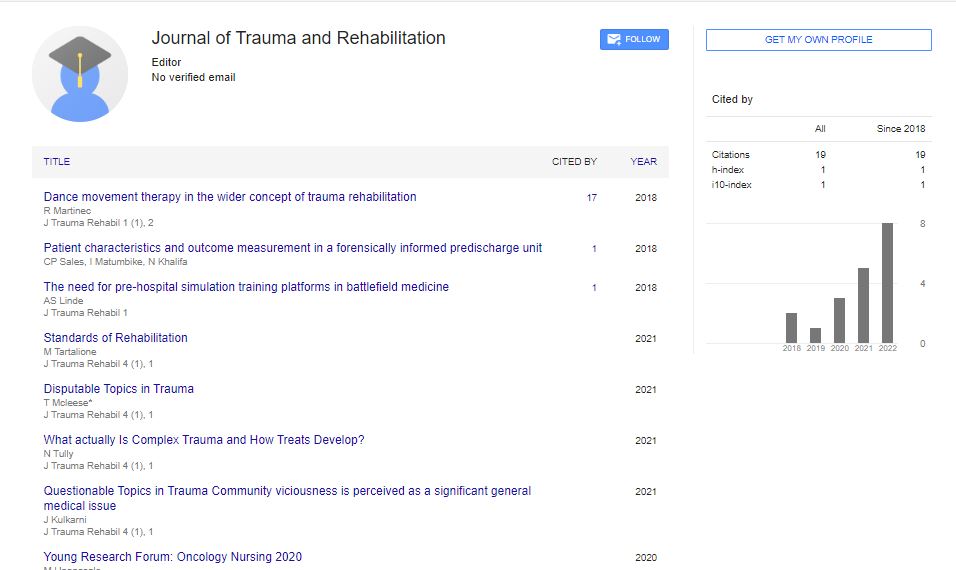Opinion Article, J Trauma Rehabil Vol: 6 Issue: 2
Understanding the Neurobiology of Traumatic Shock and Pain
Luca Rossi*
1 Department of Trauma Surgery and Rehabilitation, Federal University of Rio de Janeiro, Rio de Janeiro, Brazil
*Corresponding Author: Luca Rossi,
Department of Trauma Surgery and
Rehabilitation, Federal University of Rio de Janeiro, Rio de Janeiro, Brazil
E-mail: rossi.luca43@gmail.com
Received date: 29 May, 2023, Manuscript No. JTR-23-106892;
Editor assigned date: 31 May, 2023, PreQC No. JTR-23-106892 (PQ);
Reviewed date: 14 June, 2023, QC No. JTR-23-106892;
Revised date: 21 June, 2023, Manuscript No. JTR-23-106892 (R);
Published date: 28 June, 2023, DOI: 10.4172/Jtr.1000129
Citation: Rossi L (2023) Understanding the Neurobiology of Traumatic Shock and Pain. J Trauma Rehabil 6:2.
Description
Traumatic shock and pain are distressing responses to severe physical or emotional trauma that can have significant consequences on an individual's well-being. When faced with life-threatening or overwhelmingly distressing situations, the human body activates complex neurobiological mechanisms to cope with the experience.
The fight-or-flight response
When confronted with a traumatic event, the body initiates the "fight-or-flight" response, a primal survival mechanism that prepares individuals to either confront the threat or escape from it. The amygdala, a region of the brain responsible for processing emotions, quickly recognizes danger and signals the hypothalamus to activate the Autonomic Nervous System (ANS).
Sympathetic Nervous System (SNS): The SNS accelerates bodily functions, increasing heart rate, blood pressure, and respiration, to prepare for an immediate response to the threat.
Release of stress hormones: The hypothalamus prompts the adrenal glands to release stress hormones, primarily adrenaline and cortisol, into the bloodstream, amplifying the body's alertness and responsiveness.
The role of the amygdala
The amygdala plays a central role in the neurobiology of traumatic shock and pain. It processes emotionally charged information and helps form memories of distressing events. During a traumatic experience, the amygdala becomes hyperactive, heightening emotional responses and encoding memories of the event.
Fear conditioning: The amygdala associates the traumatic event with fear and negative emotions, leading to fear conditioning. As a result, stimuli associated with the trauma can trigger emotional and physiological responses even after the threat has passed.
Altered memory processing: Traumatic events can cause memory fragmentation and distortion due to the heightened emotional state at the time of the incident. This may lead to flashbacks or intrusive memories of the trauma.
The hippocampus and memory consolidation
The hippocampus, a brain structure involved in memory consolidation, can be affected by traumatic shock and pain. While the amygdala encodes emotional memories, the hippocampus is responsible for integrating those memories into the broader context of an individual's life experiences. However, in the presence of excessive stress hormones during a traumatic event, the hippocampus can be temporarily impaired.
Impaired memory consolidation: The heightened cortisol levels during trauma can hinder the hippocampus's ability to consolidate memories effectively, leading to fragmented and incomplete recollections of the event.
Memory suppression: As a protective mechanism, the brain may suppress or dissociate memories of the traumatic experience, making it difficult for the individual to recall the event coherently.
Neurotransmitters and emotional regulation
Traumatic shock and pain can lead to dysregulation of neurotransmitters, affecting emotional processing and mood regulation. The brain relies on various neurotransmitters, such as serotonin, dopamine, and norepinephrine, to maintain emotional balance and well-being.
Decreased serotonin: Trauma may result in reduced serotonin levels, leading to symptoms of depression, anxiety, and mood disturbances.
Altered dopamine activity: Dopamine, associated with pleasure and reward, can be dysregulated in response to traumatic stress, leading to feelings of emotional numbness and detachment.
Excessive norepinephrine: Traumatic stress triggers an increase in norepinephrine release, contributing to hyperarousal and hypervigilance.
The impact on the prefrontal cortex
The prefrontal cortex, responsible for executive functions such as decision-making, impulse control, and emotional regulation, can be adversely affected by traumatic shock and pain.
Impaired decision-making: Trauma-related alterations in the prefrontal cortex may impair an individual's ability to make rational decisions and assess risks effectively.
Emotional dysregulation: Dysfunctional prefrontal cortex activity can result in emotional dysregulation, leading to mood swings and difficulty managing intense emotions.
Long-term effects and Post-Traumatic Stress Disorder (PTSD)
For some individuals, the neurobiological impact of traumatic shock and pain can lead to the development of post-traumatic stress disorder (PTSD). PTSD is a debilitating condition characterized by intrusive memories, flashbacks, emotional numbing, and heightened arousal.
Hippocampal atrophy: In individuals with chronic PTSD, the hippocampus may experience atrophy over time, affecting memory and emotional regulation.
Amygdala hyperactivity: The amygdala's persistent hyperactivity can contribute to the persistent fear responses and emotional reactivity seen in PTSD.
Neuroplasticity and healing: While trauma can have lasting effects on the brain, neuroplasticity offers hope for healing and recovery. Psychotherapy, medication, and other interventions can support neurobiological changes that facilitate post-traumatic growth.
Conclusion
Understanding the neurobiology of traumatic shock and pain provides vital insights into the profound impact of trauma on the brain and body. The intricate interplay of brain regions, neurotransmitters, and stress hormones helps explain the immediate and long-term effects of traumatic events. Acknowledging the neurobiological basis of traumatic shock and pain is essential in developing effective treatments and support for individuals experiencing the aftermath of trauma. By promoting resilience, healing, and coping strategies, healthcare professionals can offer compassionate care to those impacted by traumatic events, fostering the path to recovery and wellbeing.
 Spanish
Spanish  Chinese
Chinese  Russian
Russian  German
German  French
French  Japanese
Japanese  Portuguese
Portuguese  Hindi
Hindi 